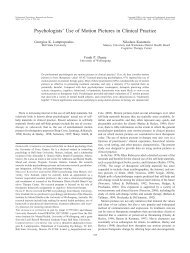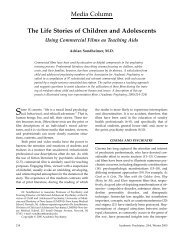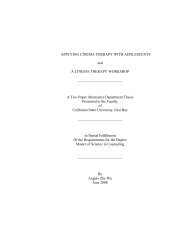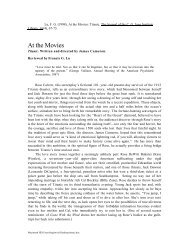Content Analysis of Romantic Comedies IN PRESS ...
Content Analysis of Romantic Comedies IN PRESS ...
Content Analysis of Romantic Comedies IN PRESS ...
You also want an ePaper? Increase the reach of your titles
YUMPU automatically turns print PDFs into web optimized ePapers that Google loves.
<strong>Content</strong> <strong>Analysis</strong> <strong>of</strong> <strong>Romantic</strong> <strong>Comedies</strong> 6First, films were chosen if they were available on Region 2 DVD. As the presentstudy was carried out in the UK, it was not possible to view films available on Region 1DVD only.Second, it was proposed that adolescents may more strongly identify with thecharacters and situations <strong>of</strong> more recent films and so only films released in cinemas between1995 and 2005 were included. Films made but not set within this period were not included.For example, Pride and Prejudice, made in 2005, was excluded due to being set during the1800s. Films that did not specify were assumed to be set in the year they were released.Third, only films rated by the British Board <strong>of</strong> Film Classification as U, PG, or 12were included. Younger adolescents with fewer <strong>of</strong> their own experiences may be moresusceptible to representations <strong>of</strong> relationships and so it was decided that the sample shouldcomprise films viewable by younger audiences.Lastly, only films produced by one <strong>of</strong> the “Big Six” major Hollywood studios(http://en.wikipedia.org/wiki/List_<strong>of</strong>_Hollywood_movie_studios) were included. Filmsproduced by major Hollywood studios typically have the widest distribution and as a resultattract the largest viewing numbers.After excluding films that did not fit into the above criteria, the top 40 <strong>of</strong> theremaining highest grossing films were then selected to be analysed, as presented in Table 1.Insert Table 1 here<strong>Analysis</strong>The aim <strong>of</strong> the current study was to document all relationship-oriented themes usinga basic grounded theory methodology. This involved three stages <strong>of</strong> coding: open; axial; andselective coding (Strauss & Corbin, 1990).The aim <strong>of</strong> open coding is to create initial categories by comparing data with datafor similarities (Charmaz, 2003) and grouping them accordingly. These initial categories are










